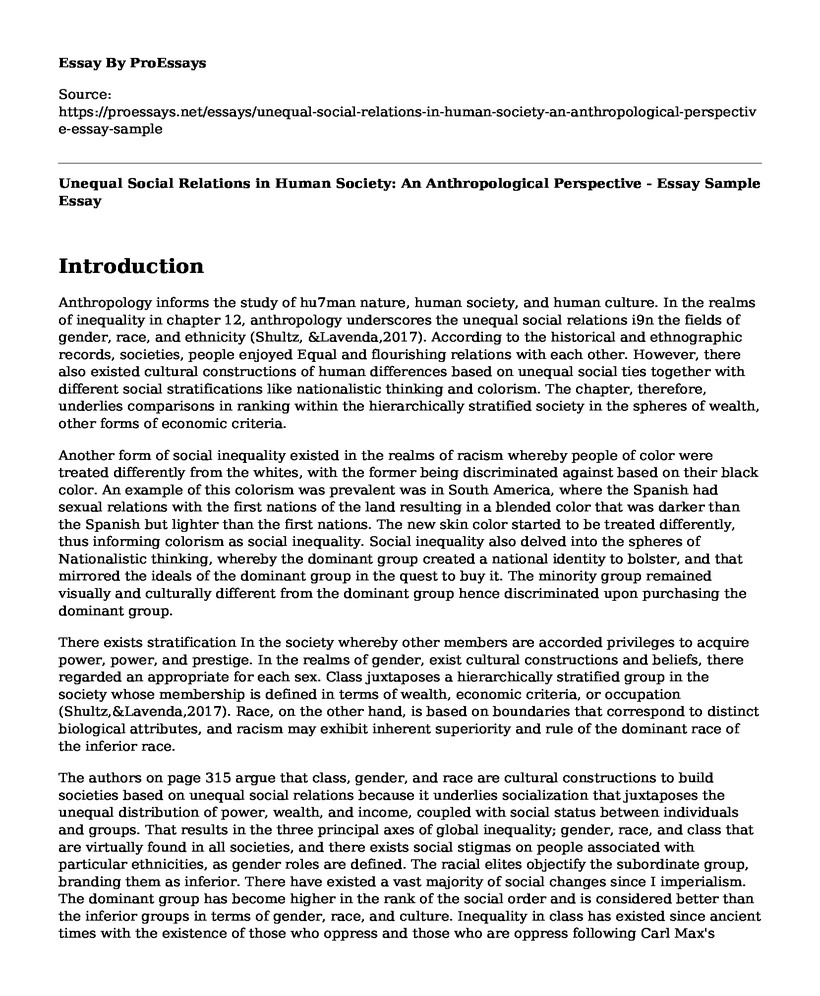Introduction
Anthropology informs the study of hu7man nature, human society, and human culture. In the realms of inequality in chapter 12, anthropology underscores the unequal social relations i9n the fields of gender, race, and ethnicity (Shultz, &Lavenda,2017). According to the historical and ethnographic records, societies, people enjoyed Equal and flourishing relations with each other. However, there also existed cultural constructions of human differences based on unequal social ties together with different social stratifications like nationalistic thinking and colorism. The chapter, therefore, underlies comparisons in ranking within the hierarchically stratified society in the spheres of wealth, other forms of economic criteria.
Another form of social inequality existed in the realms of racism whereby people of color were treated differently from the whites, with the former being discriminated against based on their black color. An example of this colorism was prevalent was in South America, where the Spanish had sexual relations with the first nations of the land resulting in a blended color that was darker than the Spanish but lighter than the first nations. The new skin color started to be treated differently, thus informing colorism as social inequality. Social inequality also delved into the spheres of Nationalistic thinking, whereby the dominant group created a national identity to bolster, and that mirrored the ideals of the dominant group in the quest to buy it. The minority group remained visually and culturally different from the dominant group hence discriminated upon purchasing the dominant group.
There exists stratification In the society whereby other members are accorded privileges to acquire power, power, and prestige. In the realms of gender, exist cultural constructions and beliefs, there regarded an appropriate for each sex. Class juxtaposes a hierarchically stratified group in the society whose membership is defined in terms of wealth, economic criteria, or occupation (Shultz,&Lavenda,2017). Race, on the other hand, is based on boundaries that correspond to distinct biological attributes, and racism may exhibit inherent superiority and rule of the dominant race of the inferior race.
The authors on page 315 argue that class, gender, and race are cultural constructions to build societies based on unequal social relations because it underlies socialization that juxtaposes the unequal distribution of power, wealth, and income, coupled with social status between individuals and groups. That results in the three principal axes of global inequality; gender, race, and class that are virtually found in all societies, and there exists social stigmas on people associated with particular ethnicities, as gender roles are defined. The racial elites objectify the subordinate group, branding them as inferior. There have existed a vast majority of social changes since I imperialism. The dominant group has become higher in the rank of the social order and is considered better than the inferior groups in terms of gender, race, and culture. Inequality in class has existed since ancient times with the existence of those who oppress and those who are oppress following Carl Max's Bourgeoisie and the proletariats, which the upper class and the middle class in the society in the realms of capitalism. Also, gender inequality exists as women are discriminated against, especially in the workplace, where men assert their dominant powers in terms of ranks and payments. Racial segregation is prevalent, especially in the US, where blacks are considered as the subordinate gender hence face social stigma.
Response
Class in anthropology underlies a double heritage as Europeans view it as boundaries that are rigid and closed. In contrast, North Americans see it as open and porous, and it may be undercut in terms of boundaries and hierarchies. Membership in class, race, and gender can determine vast differences in the lives of people in terms of biological roots than history and culture. Conceptualization of the three identities is, therefore, the essential elements that inform stereotyping, coupled with stigmatization and the struggle for dominance hence a justification for the oppression of the minority groups by the dominant group.
Reference
Shultz, E., & Lavenda, R. (2017, January). Cultural Anthropology: A Perspective on HumanCondition. Oxford University Press. Retrieved fromhttps://global.oup.com/ushe/product/cultural-anthropology9780190620684?cc=ke&lang=en&
Cite this page
Unequal Social Relations in Human Society: An Anthropological Perspective - Essay Sample. (2023, May 22). Retrieved from https://proessays.net/essays/unequal-social-relations-in-human-society-an-anthropological-perspective-essay-sample
If you are the original author of this essay and no longer wish to have it published on the ProEssays website, please click below to request its removal:
- Poverty is Capability of Deprivation
- Double Conscious is Not a Barrier to Success Essay
- Teachers Should Be Armed - Argumentative Essay
- Paper Example on Effect of Gender Differences on the Women Employed
- Effects of Divorce on Child Development Essay Example
- Essay Sample on St. Catherine of Siena: A Welcoming & Empowering Community
- Paper Example on Technology Transforming Communication: Mobile Phones to the Rescue!







